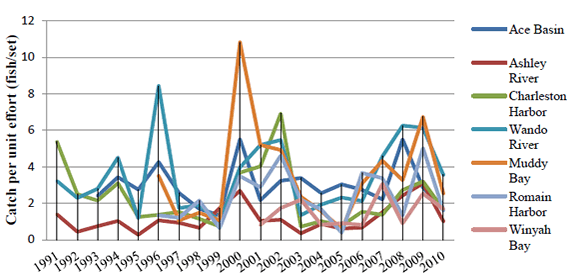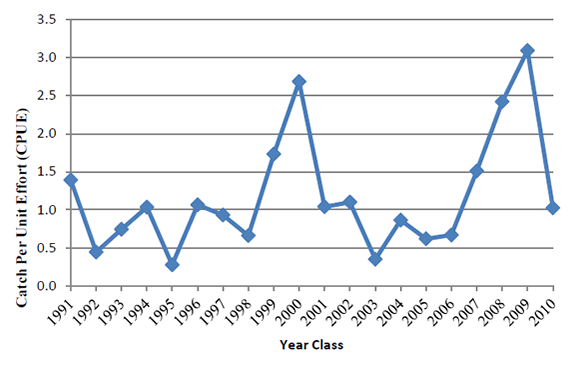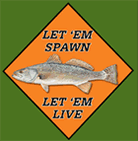Stocking Red Drum Larvae in the Ashley River
Historically, red drum, Sciaenops ocellatus, supported important commercial and recreational fisheries from North Carolina to Texas. However, population abundance has declined since the 1980’s, resulting in progressively more restrictive creel and slot limits and closure of most commercial fisheries. Overfishing appears to be a factor in the decline as anglers have become more knowledgeable and efficient at targeting all of the sub-adult year classes (ages 0-4 yrs.). As a result, fishery managers have examined remaining options for using traditional management approaches (regulations) to increase abundance; however questions remain as to whether recruitment success or failure is driven by sub-adult escapement and the number of eggs spawned by the adult population or by the survival of larvae in the estuarine nursery habitat. Many variables affect larval survival including weather conditions, food availability, timing of settlement, and changes in predator concentrations. Identifying this recruitment bottleneck is paramount to understanding red drum population dynamics, fisheries management options and the effects of conventional regulations.
The juvenile index of red drum abundance is a metric generated from independent monthly samples at random locations in seven estuaries along the South Carolina coast. This long-term dataset records the catch per unit effort (CPUE) of young-of-the-year red drum and allows fisheries managers to measure the relative recruitment success of a year class both within and among the sampled estuaries. Analysis of this dataset revealed that recruitment success in all estuaries trend similarly (fig. 1), which suggested a regional recruitment limitation most likely associated with weather phenomena such as drought, heavy precipitation, or wind, all of which can effect larval survival or larval prey survival. Further analysis revealed that the Ashley River consistently had the lowest CPUE of red drum among estuaries in the state. The results of stock enhancement efforts in the Ashley between 1999-2002 indicated that stocking 1-2 inch red drum juveniles resulted in a 4-fold increase in red drum abundance in the river. Therefore, it was hypothesized that if fish stocked as small juveniles bypassed existing recruitment bottlenecks, perhaps stocking larvae at numbers up to two orders of magnitude higher might also produce measurable returns and a provide a better understanding of what is limiting recruitment in the estuary.

In 2004, SCDNR began a 7 year study in the Ashley to improve our understanding red drum recruitment bottlenecks and assess the stocking of red drum as a practical technique for restoring red drum abundance. Adult red drum were collected from waters off Charleston and transported to laboratory facilities at the Marine Resources Research Institute for controlled maturation and spawning. Each brood fish was weighed, measured, and sex determined before being placed in 12’ diameter spawning tanks. A fin clip was taken to characterize the genetic code of each brood fish. Broodstock were conditioned to spawn by mimicking the temperature and day length found in the wild. A subsample of each release was retained and compared against the broodstock to verify genotyping.
Red drum spawn in the evenings and eggs were collected from broodstock tanks on the mornings following spawns and placed into incubation cones for hatching. Eggs hatched within 24 hours of being spawned and within 2 days of hatching, genetically marked red drum were stocked directly into the targeted estuarine system, bypassing the tidal transport and weather related impacts that may influence larval ingress into the system. Larvae were released by boat throughout the Ashley River at high tide during the natural red drum spawning season. By spreading larval releases out over the entire spawning season, researchers provided the greatest opportunity for matching the optimum environmental conditions for larval survival. A subsample of larvae were kept to verify larval quality and fitness.
Between 2004-2007, increasing numbers of larvae were released in the Ashley River each year to determine if the number of larvae stocked had an impact on contribution the next year (Table 1). After 2007, the number of larvae released was held constant. Beginning in 2007, small juveniles (about 1” in length) produced from a second genetic family were also released in the Ashley during the 12 week season. The juveniles could be genetically differentiated from the larvae during analysis and served as a control to show that conditions were available to support small juveniles.
Table 1. Larval and juvenile stocking and contribution of red drum in the Ashley River, 2004-2010.
| Year Class | Number Released (n) | Contribution (%) | ||
|---|---|---|---|---|
| Larvae | Juveniles | Larval | Juvenile | |
| 2004 | 17,487,162 | - | 0.00% | - |
| 2005 | 33,829,410 | - | 1.40% | - |
| 2006 | 48,717,015 | - | 0.30% | - |
| 2007 | 60,955,951 | 525,654 | 0.70% | 8.80% |
| 2008 | 33,239,434 | 53,560 | 0.40% | 0.00% |
| 2009 | 32,136,182 | 629,924 | 0.00% | 35.10% |
| 2010 | 33,795,385 | 729,550 | 0.50% | 17.20% |
Results of genetic analysis on young-of-the-year red drum captured in independent sampling in the Charleston Harbor estuary revealed very low levels of contribution from hatchery fish stocked in the Ashley River as larvae. Additionally, of the 8 stocked larvae which were identified in genetic samples, 5 were captured outside of the Ashley River. Consequently, CPUE for red drum in the Ashley was below the long-term average for this system between 2004-2006 (fig. 2), indicating that stocked larvae did not increase the abundance of red drum in the system. In contrast, genetic analysis identified a significant contribution of hatchery released small juveniles in the Ashley River. As a result, the catch per unit effort of red drum in the Ashley rose every year starting in 2007 and reached the highest level ever recorded for this system in 2009. This confirms that the limiting factor for a good recruitment year is probably not eggs and larvae making it into the system, but rather adequate food for small larvae or the presence of too many predators on the larvae. By stocking 1” juveniles, we can bypass this limiting effect and effectively increase contribution to the population.




